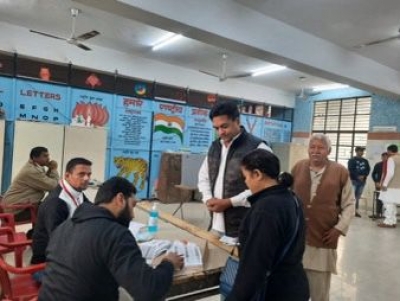Maha: Pune tops with 8,382 polling stations, Sindhudurg has lowest at 918
By IANS | Published: April 9, 2024 07:37 PM2024-04-09T19:37:55+5:302024-04-09T19:40:07+5:30
Mumbai, April 9 Of the 48 constituencies in Maharashtra, the Pune constituency tops the list with the highest ...

Maha: Pune tops with 8,382 polling stations, Sindhudurg has lowest at 918
Mumbai, April 9 Of the 48 constituencies in Maharashtra, the Pune constituency tops the list with the highest number of polling stations while Sindhudurg has the lowest number of polling stations.
Pune has a total of 8,382 polling stations while Sindhudurg has only 918.
As per the latest data compiled by the office of the Chief Electoral Officer, the number of total polling stations in the state has increased to 98,114 against 95,473 during the Lok Sabha elections held in 2019, a rise of 2,641.
The number of voters has also increased to 9.21 crore compared to 8.85 crore during the same period.
However, the office of the state chief electoral officer said that the number of polling stations may increase further as the registration of voters is still underway.
There were 64,508 polling stations during the 2004 Lok Sabha elections, 83,986 in 2009, 91,329 in 2014 and 95,473 in 2019 elections.
After Pune with 8,382 polling stations, Mumbai suburbs come second with 7,380 polling stations, Thane with 6,592, Nashik with 4,800 and Nagpur with 4,510. Sindhudurg has only 918 polling stations while the Maoist-infested Gadchiroli has 950.
There are 7 districts in Maharashtra which have more than 3,000 polling stations. These districts include Ahmednagar (3,734), Solapur (3,617), Jalgaon (3,582), Kolhapur (3,368), Sambhajinagar (3,085), Nanded (3,047) and Satara (3,025).
Further, there are 10 districts with over 2,000 polling stations. These districts consist of Raigad (2,719), Amravati (2,672), Yavatmal (2,532), Mumbai City (2,517), Sangli (2,448), Beed (2,355), Buldhana (2,266), Palghar (2,263), Latur (2,102) and Chandrapur (2,044).
Districts with less than 2,000 polling stations include the tribal-dominated Nandurbar (1,412), Dhule (1,704), Akola (1,719), Washim (1,076), Wardha (1,308), Bhandara (1,156), Gondia (1,288), Hingoli (1,017), Parbhani (1,587), Jalna (1,719), Dharashiv (1,503) and Ratnagiri (1,717).
The polling stations are established as per the maximum and minimum number of voters among various other criteria fixed by the Election Commission of India.
The poll panel takes due care to ensure that the voter does not face any difficulty in reaching the polling station. Considering the 'sensitivity' of the polling stations, necessary security is provided there.
According to the guidelines issued by the Election Commission of India, every polling station must have minimum basic facilities such as ramps for senior citizens, drinking water, toilets, electricity supply, lighting scheme, suitable width doorways for wheelchair users and furniture.
In addition, special care is taken at polling stations located in remote areas.
--IANS
sj/dan
Disclaimer: This post has been auto-published from an agency feed without any modifications to the text and has not been reviewed by an editor
Open in app